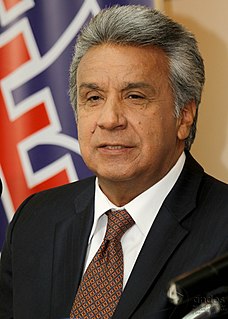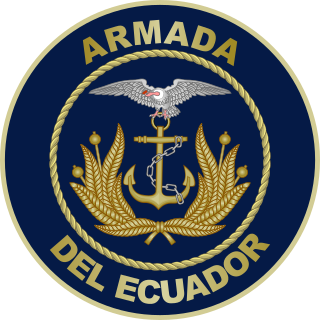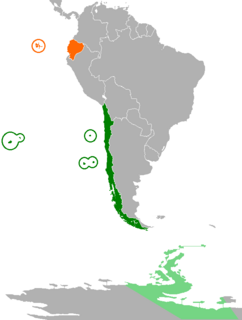Related Research Articles

Ecuador, officially the Republic of Ecuador, is a country in northwestern South America, bordered by Colombia on the north, Peru on the east and south, and the Pacific Ocean on the west. Ecuador also includes the Galápagos Islands in the Pacific, about 1,000 kilometres (621 mi) west of the mainland. The capital is Quito.
The Ecuadorian Armed Forces is the national military force of Ecuador. The commander-in-chief is the President of Ecuador, currently Lenin Moreno. The military is generally under civilian control, specifically the Ministry of National Defence. The Ecuadorian military of Ecuador has been involved in border disputes with Peru, and has provided military observers and troops to the United Nations since 1948.

The Cenepa War, also known as the Alto Cenepa War, was a brief and localized military conflict between Ecuador and Peru, fought over control of an area in Peruvian territory near the border between the two countries. The two nations had signed a border treaty following the Ecuadorian–Peruvian War of 1941, but Ecuador later disagreed with the treaty as it applied to the Cenepa and Paquisha areas, and in 1960 Ecuador declared the treaty null and void.

El Oro is the southernmost of Ecuador's coastal provinces. It was named for its historically important gold production. Today it is one of the world's major exporters of bananas. The capital is Machala.

The Peruvian Air Force is the branch of the Peruvian Armed Forces tasked with defending the nation and its interests through the use of air power. Additional missions include assistance in safeguarding internal security, conducting disaster relief operations and participating in international peacekeeping operations.

The Ecuadorian–Peruvian War, known locally as the War of '41, was a South American border war fought between 5–31 July 1941. It was the first of three military conflicts between Ecuador and Peru during the 20th century. During the war, Peru occupied the western Ecuadorian province of El Oro and parts of the Andean province of Loja. Although the war took place during World War 2, it was unrelated to that conflict.

Walter Orlando Ayoví Corozo is an Ecuadorian former professional footballer. He previously played as a left winger for Club Deportivo El Nacional in the Ecuadorian league and in the Ecuadorian national team, primarily in left defense. He is the cousin of fellow footballer Jaime Ayoví, who also plays in the Ecuadorian national team. He also holds Mexican citizenship.

The Paquisha War or Fake Paquisha War was a military clash that took place between January and February 1981 between Ecuador and Peru over the control of three watchposts. While Peru felt that the matter was already decided in the Ecuadorian–Peruvian War of 1941, Ecuador claimed that the Rio de Janeiro Protocol was not executable because a 78km section of the border was not precisely defined, what generated new confrontations

The Ecuadorian Army is the land component of the Ecuadorian Armed Forces. Its 116,450 soldiers are deployed in relation to its military doctrine. The contemporary Ecuadorian Army incorporates many jungle and special forces infantry units into its structure.

The Cenepa River is a 185-km stretch of river where its basin borders Ecuador and Peru, in the Cordillera del Cóndor mountain range in South America. Its drainage basin borders to the north on Ecuador, to the east on the districts of Río Santiago and Nieva, on the south with the district of Imaza, and on the west with Ecuador. The River has been subject to several border disputes between Peru and Ecuador the most notable was in 1995 the Cenepa War. The Awajún, the locals around the Cenepa River Basin have had issues with the legal certainty of the River due to its cultural significance and the resources. The Cenepa River has been impacted by the consequences of military action in the region through skirmishes between Ecuadorian and Peruvian forces along with the establishment of military camps and outposts. Expansion of local communities and the influence of mining have to different degrees interrupted the natural habitats of local fauna and flora. The Cenepa River has had government intervention through the growing recognition of the importance of preservation. This was a direct result of the peace talks that followed the Cenepa War in 1995.,or the Battle of Tiwinza.

Rafael Vicente Correa Delgado, known as Rafael Correa, is an Ecuadorian politician and economist who served as President of Ecuador from 2007 to 2017. The leader of the PAIS Alliance political movement from its foundation until 2017, Correa is a democratic socialist and his administration focused on the implementation of left-wing policies. Internationally, he served as president pro tempore of the UNASUR.

The Ecuadorian Air Force is the Air arm of the Military of Ecuador and responsible for the protection of the Ecuadorian airspace.

Lenín Boltaire Moreno Garcés is an Ecuadorian politician who is the current president of Ecuador, in office since May 2017. Moreno was vice president from 2007 to 2013, serving under President Rafael Correa.

Argentina–Peru relations are foreign relations between Argentina and Peru. Both countries established diplomatic relations on July 10, 1822. Both nations are members of the Community of Latin American and Caribbean States, Group of 77, Organization of American States, Organization of Ibero-American States and the United Nations.

The Mira River originates in the Andes of Ecuador and flows to the Pacific Ocean in Colombia. For a few kilometers it forms the border between the two countries. The upper course of the Mira is called the Chota River and is notable for its Afro-Ecuadorian inhabitants, its bomba music, and the large number of internationally-prominent soccer players it has produced.
Ecuador contains three distinct climatic regions: Tropical, Highland or Sierra, and Amazon rain forest. The health conditions of this country vary according to these regions. In the sierras, in cities such as Quito or Cuenca where most Ecuadorians live, health conditions most commonly associated with the tropics do not exist. For example, the types of mosquitoes which carry malaria and dengue fever cannot live at altitudes above 2300 meters as is the case in virtually all of the sierras. While there does not seem to be general agreement in the medical community about the prevalence of altitude-related conditions, some visitors to the highlands may experience symptoms. The lower atmospheric pressure of the sierras affects some individuals profoundly with difficulty in breathing, nausea and dizziness but these conditions are typically not of long duration and require a period of reduced activity and conservative eating and drinking for acclimatization. Ecuadorians living most of their lives in the sierras commonly require a brief period of re-adjustment after living at sea level for prolonged periods of time. In the low-lying coastal regions and in the Amazonian region, the predictable diseases of those climates exist. Malaria, for example, is according to UN sources no longer epidemic in Ecuador. Nor is Dengue Fever. The potential for these diseases does exist but mostly in isolated, economically-depressed areas of the Amazon and seacoast. Many do not realize that dengue-infected mosquitoes exist in the southeastern US but do not infect inhabitants on a widespread basis. Life expectancy is approximately that of the US.

San Miguel de Urcuquí Canton, or Urkuki, is a canton of Ecuador, located in the Imbabura Province. Its seat is the town of Urcuquí. Its population in the 2001 census was 14,381 and was 15,671 in the 2010 census. The area of the canton is 779 square kilometres (301 sq mi).

The Ecuadorian Navy is responsible for the surveillance and protection of national maritime territory and has a personnel of 9,127 men to protect a coastline of 2,237 km which reaches far into the Pacific Ocean. The vessels are identified by a ship prefix of B.A.E.: Buque de la Armada del Ecuador or L.A.E.: Lancha de la Armada del Ecuador.
The Brasilia Presidential Act is an international treaty signed by the then President of Ecuador, Jamil Mahuad and President of Peru, Alberto Fujimori which effectively put an end to the Western Hemisphere's longest running territorial dispute.

Chilean–Ecuadorian relations refer to official and bilateral tie between Chile and Ecuador. Two countries have embassies in respective capitals.
References
- ↑ Frank Jacobs (June 19, 2012). "Amazonia or Bust!". The New York Times . Retrieved June 20, 2012.CS1 maint: discouraged parameter (link)
- http://www.adonde.com/historia/1999_peru_ecuador.htm
- http://www.enciclopediadelecuador.com/temasOpt.php?Ind=2374&Let=
Coordinates: 3°28′20″S78°15′08″W / 3.4723°S 78.2522°W